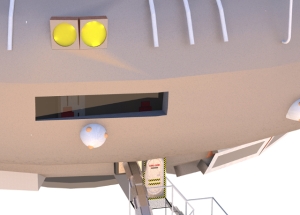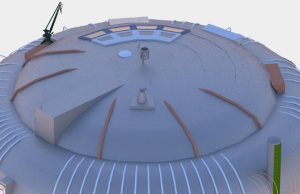This “Throwback Thursday” is going to be the start of the story of a new campaign, the Space Cowboys game that’s been mentioned several times before. Here’s some background to fill in the context.
The genre was “regular Joe’s, working a job.,.. in space”. We took inspiration from Firefly, and Serenity, and Cowboy Bebop, and dim recollections of Traveller. Player characters were the crew of an interplanetary cargo hauler, built on 150+75+5 points, though only one character from the first “season” had a full load of Disadvantages. The baseline Tech Level for PCs was 9, with TL 10 available for purchase. The available TL 9 technology used the “Safe-Tech” switch from GURPS Ultra-Tech, while the TL 10 technology was just starting to dabble in the forbidden. There would be no aliens, no faster-than-light travel, no alien worlds outside our Solar System, no super-science (with a couple of exceptions for terraforming and such), no Trained By A Master kung fu powers (though realistic martial arts became quite popular as the story wore on), no magic, no robot PC’s…
I didn’t say “no” to psychic powers or cybernetics, but I didn’t advertise them, either. Nobody asked, to begin with. I had guessed that given the background inspirations, somebody would have wanted to play a knock-off of either Jet Black or River Tam. Both appeared in the second “season”.
When I speak of seasons: the conceit was that we were playing the game of a prime-time TV show that never was. We had a theme song. Mention was made of images from the montage behind the opening credits. (We really, really missed Firefly.) The first season went for some time, then we ended it with a big “finale” session and switched over to a different campaign. Some time later, there was a change in the lineup of players, and we returned to the game for a second season.
The game began in 2517*. Earth had been used up and destroyed some time past, under the weight of ecological disaster, war, overpopulation, unwise use of nanotechnology, and the rise of hostile AI. The human race abandoned the planet over the course of several decades. Back in the 2100’s, the decision was made that anything lifting off from Earth would be assumed hostile and shot down without warning, after several close calls with attacks from the surface.
Due to the manner in which Earth fell, there was a backlash against the free application of technology. Any thinking machine was suspect. The TL 9 technology base used analog, mechanical systems in place of advanced computers. It also avoided any nanotech, genetic manipulation, or cybertech involving the brain. This tech system excelled in advanced materials and metallurgy, more than anything. This is the paradigm in place throughout most of the Solar System. Certain backwater planets might have a lower base TL, but it was assumed that this was the product of history or poverty, not culture. The local economy and manufacturing base for a given planet might only be able to provide a TL 7 living, for example… but they would be eager to obtain TL 9 goods, if available and affordable.
By contrast, the richest and most technologically advanced cultures had recently embraced computers, virtual reality, genetically-engineered creatures, and everything else their TL could provide without outright super-science. This made them just about incomprehensible to average TL 9 folks. For instance, the TL 9 people didn’t really “get” the idea of computers, having been raised on a diet of horrific legends from the past; they really didn’t get the idea of a non-volitional AI as a personal assistant living in a wearable computer and interfacing with the user through contact lenses and an earpiece. All they could see was some joker in a skintight plastic suit with some crazy wrap-around sunglasses, talking to himself, staring off into the distance, looking at things that aren’t there, and yet somehow managing to be richer than Croesus in spite of his obvious barking insanity.
The way I approached it was to think of the TL 10 people as the most early-adopter of the denizens of Akihabara, and to think of the TL 9 folks as the characters on the original Smokey and the Bandit movie**.
Before the great exodus, Mars had been terraformed, becoming a garden planet, using slow methods. Under pressure from the evacuation of the bulk of the human race, one megacorporation was formed to gather all the information about the science and practice of terraforming. They developed a proprietary process that was superior in some ways, flawed in others. They could turn just about any roundish piece of rock into a livable planet, where a human could walk around on the surface without a space suit, and they could do it in a hurry. On the down side, with no gravity manipulation, most of these new worlds were extremely low-gravity and would gradually lose their atmospheres over the course of centuries. Furthermore, they couldn’t guarantee the final results, so lots of the new worlds had quirks, like a poor climate (often frozen) or little water or vast oceans covering most of the surface.
As colonization spread, the power of the megacorps increased. Planets that were terraformed later found themselves under an increasingly heavy yoke. Between changes in the terms of terraforming and travel times between different parts of the Solar System, several factions shook out.
Nearest the sun, we find the Confederation of Core Worlds, the richest and most advanced. Chief among its members are the Loonies of Earth’s moon (who refused terraforming in favor of living in their traditional underground domes), the people of the cloud cities of Venus, the wealthy inhabitants of the cloud of habitats in orbit around Earth and the Lagrange points, and the mega-rich of Mars. The people here are all well-fed, and have plenty of toys. This is where you find your TL 10 people.
Next, there’s the Asteroid Belt Alliance, led by the people of Ceres. They’re mostly asteroid miners and other free-thinkers. They have few terraformed worlds, but uncounted numbers of hollowed-out asteroids and other habitats. The Greek Camp Coalition and the Troy Commonwealth were similar to the ABA, but based out of the two groups of asteroids at Jupiter’s Trojan points.
The Jupiter Corporate Sector controls Jupiter, Saturn, and their moons. It was set up to extract raw materials from the gas giants. The JCS acts as a government between planets, and dominates the moons it doesn’t own outright. It lacks laws, using corporate regulations in their place. The Cabra was registered to the JCS as a flag of convenience. For the most part, the only thing the JCS cared about was that their income taxes got paid.
Finally, there is the League of Outer Planets, with some claim to independent government, and the Weyland-Yutani Protectorates, which are the most recently-terraformed planets in the system, and so, “owe [their] soul to the company store”. These were the colder, poorer worlds, on the outer edges of the Solar System, including Sedna, Eris, and Quaoar.
According to rumor, some of the earliest people to leave Earth had just headed out and kept on going. The talk was that people might even be living out in the Oort cloud.
For centuries after the fall of Earth-That-Was, interplanetary trade was carried by ships using first magsails, then later, plasma sails***. These were the workhorse propulsion systems for the TL 9 tech base. However, in recent years (as of the time of the game), TL 10 fusion rockets had come of age and started taking away the more profitable routes towards the richer center of the system. The old plasma sailing ships were forced to work the longer, harder, less profitable routes among the outer worlds.
* That’s a double Easter egg, for those keeping track at home: Firefly was set in the same year, and Ezekiel 25:17 is on prominent display in Pulp Fiction.
** Premiered in 1977, the same year AD&D came out. Nobody had a cell phone.
*** Despite all my talk of “hard science fiction” and “no super-science” and so forth, I had to make the plasma sail into something magic. As part of my pre-game research, I read the book The Wreck of the River of Stars, and I fell in love with the idea of sails. I think something of the tone of the book crept in to the background of the game, as well.




